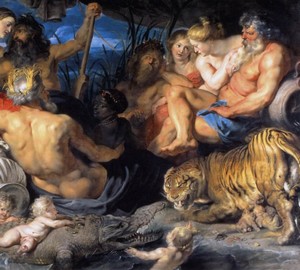
Description of the picture:
Four parts of the world – Peter Paul Rubens. 1612-1614
A prolific artist and energetic diplomat, Rubens traveled extensively and made friends with many European rulers; two of them elevated him to the knighthood. He was a highly educated man and often included symbols of ancient mythology in his pictorial allegories. Inverted urns are attributes of ancient gods who lived in the rivers of 4 continents of the world: Africa, Asia, Europe, America. These river deities are shown resting under the canopy, surrounded by the attention of naked women. The tigress represents the Tigris river, and the putti play with the crocodile, the symbol of the Nile.
CONTINENTS. Four continents are often depicted in the works of artists of the Baroque era. An example is the huge ceiling mural of Tiepolo APOLLO and four continents (c. 1750). Parts of the world were often personified by river deities and can appear in painting along with animals characteristic of these places or rely on urns from which water flows; a head under the veil indicates that the source of the river is unknown. Africa can wear corals, portrayed with a sphinx, lion or elephant; America is dressed in a hunter suit with a headdress of feathers, and coins symbolize rich natural resources; Asia can be depicted with a camel, rhino, elephant, palm trees, precious stones or exotic incense, and Europe in the form of a bull or horse, and it can hold a cornucopia or crown of excellence, sometimes surrounded by figures representing art."